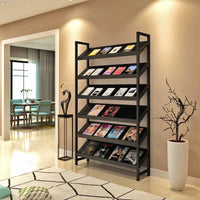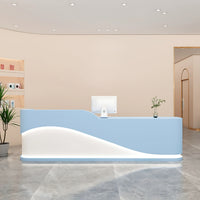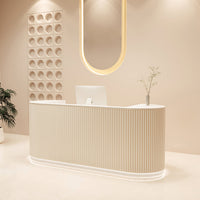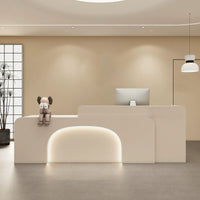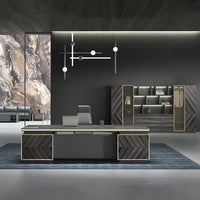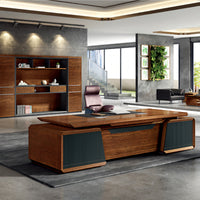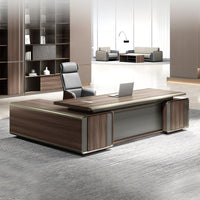How to Build a Realistic Reception Desk?
kaguyasuContent Menu
● Planning Your Reception Desk Project
>> Assessing Your Needs and Space
>> Setting a Budget
>> Selecting a Design Style
● Choosing Materials and Tools
>> Popular Material Options
>> Essential Tools
● Reception Desk Design Considerations
>> Size and Shape
>> Functionality and Ergonomics
● Building the Reception Desk Step by Step
>> 1. Create Detailed Plans
>> 2. Prepare Materials and Workspace
>> 3. Build the Desk Frame
>> 4. Add Storage and Features
>> 5. Finish and Assemble
>> 6. Install the Desk
● Customization and Personalization
● Maintenance and Longevity
● Frequently Asked Questions
● Citations:
A reception desk is more than just a piece of furniture—it's the first impression of your business, a hub for organization, and a functional workspace for staff. Building a realistic reception desk requires careful planning, an understanding of materials and design, and attention to both aesthetics and practicality. This comprehensive guide will walk you through every step of the process, from initial concept to final installation, ensuring your reception desk is both impressive and functional.

Planning Your Reception Desk Project
Assessing Your Needs and Space
Before picking up any tools, start by evaluating the space where your reception desk will be placed. Measure the available area, taking into account the flow of traffic, existing furniture, and accessibility needs. Consider how many people will be working at the desk and what tasks they'll perform—will they need space for computers, phones, paperwork, or guest sign-in? Plan for enough surface area and storage to handle daily operations comfortably.
Think about the placement of electrical outlets for computers and other devices, and ensure the desk is visible and welcoming to visitors as they enter. If your reception area serves a high volume of guests, allocate space for waiting areas, display racks, or additional features like coffee stations.
Setting a Budget
Establish your budget early to avoid overspending. List all necessary materials—wood, metal, glass, fasteners, finishes—and factor in the cost of tools if you don't already own them. Consider whether you'll need to hire help for specialized tasks like electrical work or custom fabrication. Set aside a contingency fund for unexpected expenses, such as design changes or material upgrades.
Selecting a Design Style
Choose a design that complements your business's identity and the surrounding décor. Modern desks often feature clean lines and minimalist finishes, while traditional styles may include ornate details and rich wood tones. Think about durability and maintenance—some materials are easier to clean and more resistant to wear than others. Make sure your design balances aesthetics with daily functionality.
Choosing Materials and Tools
Popular Material Options
The materials you select will influence the desk's appearance, durability, and cost. Here are some common choices:
- Laminate: Affordable, durable, and available in many colors and patterns. Laminate desks are easy to clean and maintain.
- Solid Wood: Offers a luxurious, professional appearance. Solid wood is durable but can be expensive and may require more maintenance.
- Metal: Aluminum, stainless steel, or other metals give a modern, industrial look and are highly durable.
- Glass: Adds sophistication and openness, making spaces feel larger. Glass desks are elegant but require frequent cleaning and careful handling.
- Stone (Marble, Quartz, Granite): Provides a high-end, durable surface. Stone is heavy and costly but makes a strong impression.
- Veneer: A thin layer of real wood applied to a less expensive core. Veneer offers the look of solid wood at a lower cost.
Consider combining materials for a unique look, such as a wood base with a glass countertop or metal accents for an industrial flair.
Essential Tools
Having the right tools ensures a smooth building process. Basic tools include:
- Measuring tape
- Circular saw or handsaw
- Drill and drill bits
- Screwdrivers (manual or electric)
- Sanding block or electric sander
- Clamps
- Paint brushes or rollers for finishing
Safety gear is also important: wear safety glasses, dust masks, gloves, and ear protection when using power tools.
Reception Desk Design Considerations
Size and Shape
The desk's size should suit both the available space and the needs of your staff. For most offices, a combination of heights works best: a higher counter (40–42 inches) for standing visitors and a lower work surface (28–30 inches) for seated staff. Leave at least 60 inches of clearance around the desk for comfortable movement.
Popular shapes include:
- Straight: Simple and space-efficient, ideal for smaller areas.
- L-Shaped: Provides extra workspace and storage, great for multitasking.
- U-Shaped: Offers maximum surface area and is suitable for larger reception areas.
- Curved or Circular: Creates a welcoming, modern look and guides visitors naturally.
- Floating: Wall-mounted for a minimalist, airy feel.
Choose a shape that fits your space and workflow.
Functionality and Ergonomics
A reception desk must be more than attractive—it should support daily tasks efficiently. Plan for:
- Adequate workspace for computers, phones, and paperwork
- Storage solutions (drawers, shelves, cabinets)
- Cable management for a tidy appearance
- Accessibility features (such as a lowered counter section for wheelchair users)
- Security considerations if the area handles sensitive information or valuables
Think about how the receptionist will access the desk and whether features like gates, flaps, or security glazing are necessary.
Building the Reception Desk Step by Step
1. Create Detailed Plans
Draw up detailed plans or find free reception desk blueprints online. Include precise measurements, materials lists, and assembly instructions. If you're customizing the design, use 3D modeling software or graph paper to visualize the finished piece.
2. Prepare Materials and Workspace
Purchase all materials and set up a clean, well-lit workspace. Pre-cut wood or panels to the required sizes if possible. Organize your tools and safety equipment for easy access.
3. Build the Desk Frame
Start by assembling the main frame using plywood, MDF, or solid wood panels. Attach side panels to the front, ensuring all joints are square and sturdy. Use wood glue and screws for extra strength. If your design includes a back panel, attach it next, followed by the desktop surface.
4. Add Storage and Features
Install shelves, drawers, or cabinets as needed. Make sure all components fit snugly and operate smoothly. Add cable management holes or channels to keep wires organized and out of sight.
5. Finish and Assemble
Sand all surfaces to remove rough edges. Apply paint, stain, or laminate according to your design. Allow finishes to dry completely before final assembly. Attach decorative elements, metal trims, or glass panels as needed.
6. Install the Desk
Move the completed desk into position. Secure it to the floor or wall if required for stability. Connect any electrical components and test for functionality. Add seating, signage, and other finishing touches to complete the reception area.
Customization and Personalization
Personalize your reception desk to reflect your brand. Consider adding:
- Company logos or signage
- Accent lighting (LED strips or spotlights)
- Unique hardware or handles
- Contrasting materials or colors
- Greenery or decorative panels
These touches make your desk memorable and reinforce your business identity.
Maintenance and Longevity
To keep your reception desk looking its best:
- Clean surfaces regularly with appropriate cleaners
- Repair scratches or dents promptly
- Check fasteners and joints periodically for stability
- Refinish or repaint as needed to maintain appearance
Choose durable materials and finishes that withstand daily use and are easy to maintain.
Frequently Asked Questions
Q1: What is the ideal height for a reception desk?
A: Most reception desks feature a dual-height design: 40–42 inches for the visitor counter and 28–30 inches for the seated work surface. This accommodates both standing guests and seated staff.
Q2: Which materials are best for a durable reception desk?
A: Laminate and metal are popular for durability and low maintenance. Solid wood and stone offer luxury and longevity but may require more care.
Q3: How much space should I leave around the reception desk?
A: Leave at least 60 inches of clearance around the desk for comfortable movement and accessibility.
Q4: What shapes are most popular for reception desks?
A: Straight, L-shaped, U-shaped, curved, and circular desks are all popular, each offering different benefits for space and workflow.
Q5: How can I make my reception desk accessible for wheelchair users?
A: Include a lowered counter section (28–34 inches high) with adequate knee clearance to meet ADA guidelines and ensure all guests can interact comfortably.
Q6: How do I manage cables and electronics in a reception desk?
A: Plan for cable management holes, channels, or trays to keep wires organized and hidden, reducing clutter and safety hazards.
Q7: Can I build a reception desk myself, or should I hire a professional?
A: Many people successfully build their own desks with basic carpentry skills and the right tools. For complex designs or high-end materials, hiring a professional may be advisable.

---
Citations:
[1] https://archicfurniture.com/blogs/furniture/diy-receptionist-desk
[2] https://www.brooklynmillwork.com/posts/6-types-of-materials-used-for-custom-reception-desks
[3] https://a2zmillwork.com/blog/ultimate-guide-to-reception-desk-design-amp-intricate-workshop-drawings/
[4] https://offisavvy.com/the-ultimate-reception-desk-buyers-guide/
[5] https://learningcentre.officeinteriors.ca/blog/reception-desk-101
[6] https://loveyourworkspace.co.uk/5-steps-successful-reception-desk-design/
[7] https://kaguyasu.com/blogs/blog/reception-desks-an-in-depth-guide
[8] https://www.youtube.com/watch?v=QoO8MQpT26E
[9] https://www.youtube.com/watch?v=WJsSsWwZT78
[10] https://www.reddit.com/r/DIY/comments/113xeg4/reception_desk_build_for_my_wifes_dog_training/
[11] https://elementsmfg.com/project/behind-the-scenes-reception-desks/
[12] https://www.youtube.com/watch?v=yosecgWLhRE
[13] https://www.furngully.com/blog/5-tips-for-choosing-a-reception-desk-for-your-corporate-office
[14] https://boofurniture.com/how-deep-long-reception-desk-space-behind/
[15] https://www.reddit.com/r/TwoPointHospital/comments/9cnld0/is_there_any_benefit_to_building_a_reception_room/
[16] https://90degreeofficefurniture.com/your-custom-made-modern-reception-desk-what-you-need-to-know-for-sure
[17] https://www.askcody.com/blog/visitor-management-solution-for-common-front-desk-problems
[18] https://www.talkshopbot.com/forum/archive/index.php/t-16711.html
---
Hot Tags: China, Global, OEM, private label, manufacturers, factory, suppliers, manufacturing company

